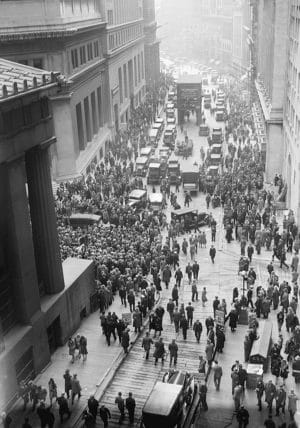
A crowd gathers outside the New York Stock Exchange on Oct. 29, 1929. U.S. government photo | Public domain
What: Stock market crashes
When: 1907, 1929 and 1987
Where: Wall Street
While evidence does not support the theory, known as the October effect, that stock markets decline during the month, October has seen some of American history’s most notable market crashes. The Panic of 1907, which would later lead to banking reforms and the creation of the Federal Reserve system, began in the second half of the month.
Oct. 24, 1929 – known as Black Thursday – began the Great Depression. While the market recovered much of its losses before the Dow Jones Industrial Average closed that day, the next week saw the downturn continue. On Oct. 28, Black Monday, stocks fell 12.8 percent, and on Black Tuesday they dropped 11.7 percent. March 16, 2020 would later edge out Oct. 28 as the second-largest single day market decline.
The largest market decline happened on another Black Monday, Oct. 17, 1987. The Dow dropped 22.6 percent, and major markets around the world also saw declines that day or the next. The 1987 crash would lead to several trading reforms.
“October. This is one of the peculiarly dangerous months to speculate in stocks in. The others are July, January, September, April, November, May, March, June, December, August, and February.”
—Mark Twain in the 1894 novel, “The Tragedy of Pudd’nhead Wilson.”
To celebrate its 150th anniversary, Banker & Tradesman is highlighting significant moments in the history of Massachusetts’ real estate and banking industries. To suggest a topic, email editorial@thewarrengroup.com.




